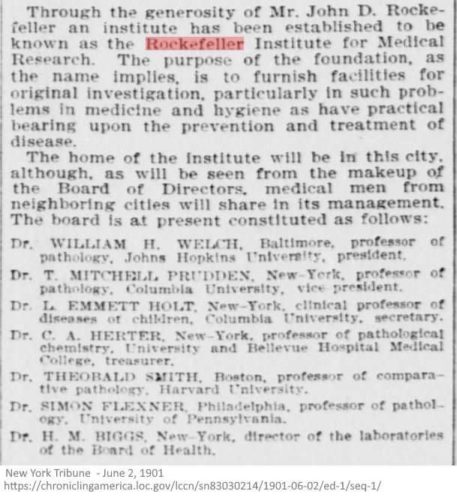In March 1901 John D. Rockefeller Sr. finally, following the death of John Rockefeller McCormack, his 3-year old “favorite” grandchild to scarlet fever, Senior commited to funding the establishment of a medical reasearch institue in New York, which was reported June 2, 1901 to be called the Rockefeller Institute for Medical Research (The Institute). Beginning with $20,000 a year grant to medical researchers and soon thereafter a $1 million gift from Rockefeller. [1, 2]
As reported in 1901, the formation of the institute will have “far reaching effects on medical science”, it’s purposes for “systematic research work” with “its immediate object the ascertainment of new facts bearing on the casuses of diseases and the methods of their prevention and cure,” and of which “a number of men eminent in pathological research” will direct and control. The Rockefeller Institute became “first institution in the United States devoted solely to using biomedical research to understand the underlying causes of disease.” Following Koch and Pasteur Institutes lead.

Some history: In 1887, during the rebuilding of the University of Chicago, John D. Rockefeller Sr. met Frederick Taylor Gates, a Baptist minister, who in 1892 became JDR’s trusted advisor. Gates believed the key to curing disease lay in scientific research and was fascinated with the “regular” physician’s emphasis of diagnosing and treating disease, a practice laid out by Dr William Osler, Johns Hopkins Hospital’s first physician-in-chief.
Gates proposed establishing the medical research institute, he played a “central role in the Rockefeller philanthropies and the importance of these philanthropies in the development of scientific medicine” [5]
Rockefeller Senior used a homoeopathic physician, which was common among the “upper class”, and was a lifelong follower of homeopathy, he objected to any move that strengthened the “regular” profession and wanted to ensure both were treat the same. To get around his concerns, Gates and JD Rockefeller Junior agreed to exclude any university affiliation for their institute project. [4]
William Welch the first dean of the Johns Hopkins School of Medicine, become the first president of the Board of Scientific Directors of The Institute, and he chose Dr Simon Flexner, his former pupil, as its first director, where Flexner stayed for 32 years. “Right from the beginning, Johns Hopkins played a key role in shaping the Rockefeller Institute, and over the succeeding decades, some of Rockefeller’s most influential faculty and board members would come from the Baltimore institution” [3]
Commissioned by NY Dept Health following 1905 meningitis epidemic (Diplococcus intracellularis), Dr Simon Flexner conducted animal experiments and “developed a novel delivery system for an anti-meningitis serum”, which was used on only “three cases” that hadn’t died, and was praised first by news media as “a cure” on Aug 6, 1907, before Flexner submited (Nov 9, 1907) his paper to The Journal of Experimental Medicine which was published Jan 1, 1908 was concluded the observations from 47 case reports were too few to draw conclusions where 21% died. [6, 7, 8, 9, 10]
The Rockefeller Instituted for Medical Reasearch was “originally devoted to experimental investigations on animals in line” with other institutes around the the world namely: Pasteur Institute in Paris, the Lister Institute in London, the Berlin, Vienna and Frankfurt Experimental Institutes, the Imperial Institute at St. Petersburg and the Institute for Infectious Diseases at Tokyo”, but in the fall (Oct 17) of 1910 it opened “a hospital with seventy beds for the experimental study and treatment of selected classes of human patients.” [11]
The Rockefeller Hospital opened on the Institute’s campus in October 17, 1910, where Simon Flexner recruited Rufus Cole as director, an Osler acolyte. The hospital plus research campus become America’s first facility for clinical research. It opened just months after Abraham Flexner Report was released – of which Welch, Simon Flexner “assisted“!
[The term, clinical research, had been in the air and discussed since 1904 by the homoeopaths. A conjoined (allopathic v homeopathic) clinical test proposed and formally published, in abbreviated form, in the New England Medical Gazette, in March, 1907, on page 63.]
“Cole was a fan of what was known as the “full-time plan,” meaning that the doctors who staffed the hospital didn’t practice privately.” A plan that was adopted by Johns Hopkins in 1913, when Abraham Flexner sold Welch the “salary” idea.
In 1953 The Institute was expanded its mission to include education, and granted its first doctoral degrees in 1959, which were admitted in 1955. In 1965 The Institute name was changed to The Rockefeller University, broadening it’s mandate further into physics and mathematics. In 1972 the university began a collaboration with Cornell University to offer graduate students an M.D.-Ph.D. program. Later, the Sloan-Kettering Institute became a partner in what is now known as the Tri-Institutional Program.” Their graduates have “gone on to influential positions in academia, industry and other fields”. But “biomedical research has remained at the center of the university’s mission,” wanting to solve “urgent public health problems.” [6]
Separate to the Institute, on April 24, 1913 the New York State Legislature passes an Act to incorporate the Rockefeller Foundation. The statement of purpose reads: “To promote the well-being of mankind throughout the world.” The New York Governor William Sulzer approves the charter on May 14, 1913. That same year John D. Rockefeller Sr. made gifts to the Foundation totaling $35 million, and 1914 $65 million. [1, 2, 3]
